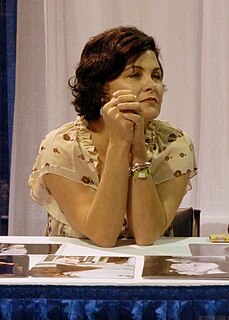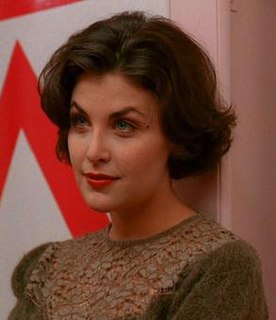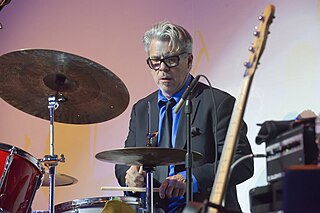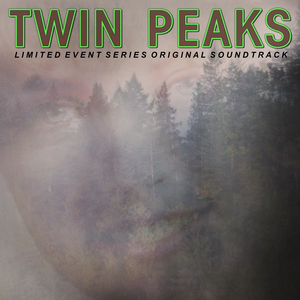
Twin Peaks is an American mystery serial drama television series created by Mark Frost and David Lynch. It premiered on ABC on April 8, 1990, and originally ran for two seasons until its cancellation in 1991. The show returned in 2017 for a third season on Showtime.

Twin Peaks: Fire Walk with Me is a 1992 psychological horror film directed by David Lynch and written by Lynch and Robert Engels. It serves as a prequel to the television series Twin Peaks (1990–1991), created by Mark Frost and Lynch, who were also executive producers. It revolves around the investigation into the murder of Teresa Banks and the last seven days in the life of Laura Palmer, a popular high school student in the fictional Washington town of Twin Peaks. Unlike the series, which was an uncanny blend of detective fiction, horror, the supernatural, offbeat humor, and soap opera tropes, the film has a much darker, less humorous tone.
Angelo Badalamenti is an American composer, best known for his work scoring films for director David Lynch, notably Blue Velvet, the Twin Peaks saga, The Straight Story, and Mulholland Drive. Badalamenti received the 1990 Grammy Award for Best Pop Instrumental Performance for his "Twin Peaks Theme", and has received a Lifetime Achievement Award from the World Soundtrack Awards and the Henry Mancini Award from the American Society of Composers, Authors and Publishers.

Sherilyn Fenn is an American actress and author. She came to attention for her performance as Audrey Horne on the television series Twin Peaks for which she was nominated for a Golden Globe Award and an Emmy Award.

Julee Ann Cruise was an American singer, songwriter and actress, best known for her collaborations with composer Angelo Badalamenti and film director David Lynch in the late 1980s and early 1990s. She released four albums beginning with 1989's Floating into the Night.
The Black Lodge is a fictional setting featured in the television series Twin Peaks. It is an extradimensional place which seems to include, primarily, the "Red Room" first seen by Agent Cooper in a dream early in the series. As events in the series unfold, it becomes apparent that the characters from the Red Room, the room itself and the Black Lodge, along with the White Lodge, are connected.

Audrey Horne is a fictional character from the ABC television series Twin Peaks, played by Sherilyn Fenn. The character was created by David Lynch. She was introduced in the pilot. The daughter of Ben and Sylvia Horne, sister of Johnny Horne and half-sister of Donna Hayward, her storylines focused on her infatuation with the series protagonist Dale Cooper, infiltrating the brothel/casino One Eyed Jacks and becoming an activist through civil disobedience.
The music of the American television series Twin Peaks, its 1992 prequel film Twin Peaks: Fire Walk with Me, and its 2017 revival series was composed by Angelo Badalamenti. Twin Peaks' co-creator David Lynch wrote lyrics for five songs used throughout the series—including "Falling", "The Nightingale", "Into the Night", "Just You", and "Sycamore Trees"—and three songs featured in Twin Peaks: Fire Walk with Me, including "A Real Indication", "Questions in a World of Blue" and "The Black Dog Runs at Night". Julee Cruise, who made cameo appearances in both the series and film, provided vocals for four of Lynch's and Badalamenti's collaborations, and jazz vocalist Jimmy Scott performed on "Sycamore Trees". Three of the series' actors—James Marshall, Lara Flynn Boyle, and Sheryl Lee—provided vocals for "Just You".

Floating into the Night is the debut studio album by American singer Julee Cruise. It was released on September 12, 1989, by Warner Bros. Records, and features compositions and production by Angelo Badalamenti and film director David Lynch. Songs from the album were featured in Lynch's projects Blue Velvet (1986), Industrial Symphony No. 1 (1990), and Twin Peaks (1990–1991).

"Falling" is a song by American dream pop singer Julee Cruise. It is the lead single and second track from her debut studio album, Floating into the Night (1989). Featuring music composed by Angelo Badalamenti and lyrics written by David Lynch, an instrumental version of "Falling" was used as the theme song for the ABC television series Twin Peaks and its Showtime revival.

Stephen Hodges is an American percussionist and composer. He is best known for his work with Mavis Staples, Tom Waits, Mike Watt, T Bone Burnett, Rick Holmstrom, and film director David Lynch.

The soundtrack for the film Twin Peaks: Fire Walk with Me was composed by Angelo Badalamenti and released on August 7, 1992, by Warner Bros. Records.
"Episode 1", also known as "Traces to Nowhere", is the second episode of the first season of the American mystery television series Twin Peaks. The episode was written by series creators David Lynch and Mark Frost, and directed by Duwayne Dunham. "Episode 1" features series regulars Kyle MacLachlan, Michael Ontkean, and Richard Beymer.

Soundtrack from Twin Peaks is a soundtrack album by American composer Angelo Badalamenti. It was released on September 11, 1990, by Warner Bros. Records and is the official soundtrack to the television series Twin Peaks (1990–1991). Though mostly instrumental, three tracks feature vocals by Julee Cruise.

Plays the Music of Twin Peaks is a tribute album by American experimental band Xiu Xiu. Composed of cover versions of the music from the Twin Peaks soundtrack, it was released exclusively as a Record Store Day release on April 16, 2016 by Polyvinyl in the United States and Bella Union in Europe. It was produced by former Xiu Xiu member Jherek Bischoff and mixed by Deerhoof member Greg Saunier.

The third season of Twin Peaks, also known as Twin Peaks: The Return and Twin Peaks: A Limited Event Series, consists of 18 episodes and premiered on Showtime on May 21, 2017. Developed and written by creators David Lynch and Mark Frost, the season is a continuation of the 1990–1991 ABC series and its 1992 theatrical prequel Twin Peaks: Fire Walk with Me. An ensemble of returning and new cast members appear, led by original star Kyle MacLachlan and directed by Lynch.

The following discography of David Lynch, an American director and musician, consists of three studio albums, two collaborative studio albums, six soundtrack albums, two spoken-word albums, one extended play, twenty singles and six music videos.

"Episode 9", also known as "Coma", is the second episode of the second season of the American mystery television series Twin Peaks. The episode was written by Harley Peyton, and directed by series co-creator David Lynch. It features series regulars Kyle MacLachlan, Michael Ontkean, Ray Wise and Richard Beymer; and guest stars Chris Mulkey as Hank Jennings, Miguel Ferrer as Albert Rosenfield, David Patrick Kelly as Jerry Horne. Don S. Davis as Major Garland Briggs, Victoria Catlin as Blackie O'Reilly, Don Amendolia as Emory Battis, Frances Bay as Mrs. Tremond, Grace Zabriskie as Sarah Palmer, and Catherine E. Coulson as the Log Lady.

Twin Peaks: Limited Event Series Original Soundtrack is a soundtrack album by American composer Angelo Badalamenti. It was released on September 8, 2017, by Rhino Entertainment. The album is the score to the Twin Peaks revival series, and includes previously unreleased compositions by Badalamenti.

Thought Gang is a studio album by American composers Angelo Badalamenti and David Lynch created under the joint moniker Thought Gang. Though released on November 2, 2018 through Sacred Bones Records, Thought Gang was originally recorded in the early 1990s. The album was preceded by a Lynch-directed music video for "A Real Indication" on November 1, 2018. The video was created in 1992 in the 8mm video format.



















